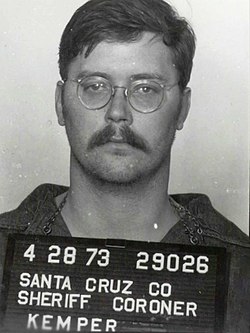
Episode 1 - Edmund Kemper
Episode 1 - The Co-Ed Killer Edmund Kemper - Blog about the show, make sure to check us out on your favorite podcast platform!
TRUE CRIME
Daniel



The Mind of a Monster: The Chilling Story of Edmund Kemper
The annals of American crime are filled with dark figures, but few are as intellectually daunting and horrifically brutal as Edmund Emil Kemper III. His story is not just a catalog of gruesome acts but a profound case study in how a toxic upbringing, combined with a brilliant but twisted mind, can forge a perfect monster. This is the story of the Co-Ed Killer.
A House of Horrors: The Making of a Monster
Edmund Kemper was born on December 18, 1948, into a Burbank, California, household defined by misery and abuse. His parents' marriage was a battleground, and his father, a WWII veteran, ultimately abandoned the family, leaving young Edmund at the mercy of his mother, Clarnell.
Clarnell Kemper was the architect of her son’s torment. She was a cruel, mentally unstable woman who subjected Edmund to relentless emotional and psychological abuse. She consistently belittled his intelligence and appearance, locking him in the dark basement as punishment. She even told mental health professionals she believed her son was destined for a dark path. His father’s later quote summed up the environment perfectly: suicide missions in wartime and atomic bomb tests were "nothing compared to living with his mother."
The warning signs emerged early. As a child, Kemper exhibited a fascination with the macabre, performing cruel acts on animals. He once buried the family cat alive and erected a cross above its grave. This disturbing behavior was a grim preview of the violence to come.
The First Kill: A Grandmother’s Warning Comes True
On August 27, 1964, at just 15 years old, Kemper’s dark fantasies became reality. After an argument with his grandmother, Maude, he retrieved his grandfather’s .22 caliber rifle and shot her dead. When his grandfather, Edmund Sr., returned home, Kemper killed him too.
He later coldly stated his motive was a mix of hatred for his grandmother and a simple desire to "see what it felt like to kill someone." Diagnosed as a paranoid schizophrenic, he was deemed criminally insane and committed to the maximum-security Atascadero State Hospital. There, his high IQ allowed him to brilliantly manipulate his psychiatrists, convincing them he was rehabilitated. Against the warnings of some staff, he was released at age 21 in 1969.
The Co-Ed Killer Emerges
Kemper attempted a normal life, getting a job with the California Highway Department. But the urges festering since childhood soon overwhelmed him. In 1972, he began trolling for victims, preying on a specific type: young, female hitchhikers.
His first victims were Mary Ann Pesce and Anita Luchessa, two bright 18-year-old college students he picked up on May 7, 1972. He drove them to a secluded area, stabbed and strangled them, and then transported their bodies back to his apartment where he committed unspeakable acts of violation and mutilation. He disposed of their remains near Loma Prieta Mountain, a chilling pattern he would repeat.
He continued his spree:
Aiko Koo (15): A dance student he strangled on September 14, 1972.
Cindy Schall (18): A student he shot and killed on January 7, 1973, later hiding her body in his closet at his mother’s house.
Rosalind Thorpe (23) and Allison Liu (20): Two University of California, Santa Cruz students he shot on February 5, 1973. He later beheaded them, explaining that the head was "the person" and the body was "nothing" without it.
The Final Act: Matricide
The primary target of Kemper’s rage had always been his mother. On the night of April 20, 1973, after she made a snide remark, he waited for her to fall asleep and then bludgeoned her to death with a claw hammer before slashing her throat and decapitating her. In a final act of twisted vengeance, he placed her head on a shelf and threw darts at it. He ripped out her tongue and larynx and tried to grind them in the garbage disposal, stating, "It felt appropriate, given how she had berated and screamed at me over the years."
To complete his horrific finale, he invited his mother’s best friend, Sara “Sally” Hallett (59), over and strangled her. He then fled California, driving over 1,000 miles to Colorado before finally calling the police to confess, stating he was emotionally drained and that his actions had served no purpose.
Trial, Imprisonment, and a Chilling Legacy
Kemper’s defense tried an insanity plea, but three court-appointed psychiatrists found him legally sane. The jury agreed, convicting him on all eight counts of first-degree murder on November 8, 1973. He requested "death by torture," but with California's moratorium on capital punishment, he was sentenced to life.
In prison, Kemper became a "model prisoner," known for his high intelligence and unsettling self-awareness. He narrated audiobooks for the blind and was extensively interviewed by FBI profilers seeking to understand the criminal mind. They found him brilliant, articulate, and chillingly logical about his own pathologies. He has been repeatedly denied parole since first becoming eligible in 1979, and remains behind bars to this day.
Edmund Kemper’s story remains a stark reminder of the devastating impact of childhood abuse and the terrifying potential of a brilliant mind unmoored from empathy and morality. He is a monster who understood his own monstrosity better than anyone else ever could.



